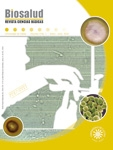Authors
Abstract
This text states the vital necessity to carry out a deep and suitable research, not only from the neuroscience perspective, but also from the diverse homeostatic values of several enteogens, which are derived from substances affecting human behaviour. From the neuroscience basis, such research will allow to understand the elements in both the therapeutic and recreational use of these substances. The most objective knowledge on the personal doses will serve the law representatives to be able to act regarding the legislative administration of the possession or the use of some enteogens. This term refers to the substances used for either recreational or therapeutic use, such as the treatment of diseases. These substances are widely employed illegally around the world infringing legal norms. Although they have not been validated by neuroscience they have been legitimized by some people based on the varied therapeutic uses that receive theoretical support from some fundamental concepts that have not yet been studied from the perspective of the homeostatic brain values of enteogens.
Keywords
References
Plomin R, DeFries JC, McClearn GE. Genética de la conducta. Segunda edición. Madrid: Alianza editorial; 1984.
Lader M. Addiction and the pharmacology of cannabis: implications for medicine and the law. Med Sci Law 2009;49:1-17.
Russo EB. Cannabinoids in the management of difficult to treat pain. Ther Clin Risk Manag 2008;4:245-259.
Hashimotodani Y, Ohno-Shosaku T, Kano M. Endocannabiboids and Synaptic function in the CNS. Neuroscientist 2007;13:127-137.
Piomelli D. El cannabis: de la droga al medicamento. Mundo Científico 1999; 206:42-48.
Ulloque RS. Farmacología de la cocaína. Tribuna Médica 1999;5:219-228.
Laprairie JL, Murphy AZ. Neonatal injury alters adult pain sensitivity by increasing opioid tone in the periaqueductal gray. Front Behav Neurosci 2009;3:31.
Fogarty A, Rawstore P, Prestage G, Crawford J, Grierson J, Kippay S. Marijuana as theraphy for people living with HIV/AIDS: social and health aspects. AIDS Care 2007;19:295-301.
Soto E. El placer, el cerebro y las nuevas drogas. Elementos 2006;64:53-58.
Gruart A, Delgado JM, Escobar C, Aguilar R. Los relojes que gobiernan la vida. Primera edición. México: Fondo de Cultura Económica; 2002.
Rogers SW. Allosaurus, crocodiles, and birds: evolution clues from spiral computed tomography of an endocast. The Anat Rec (New Anat) 1999;257:162-173.
Cook R, Calebrese E. The importance of hormesis to public health. Cien Saude Colet 2007;12:955-963.
Duque JE. La crítica: base de la construcción por diálogo de saberes. Biosalud 2004;3:4.
Zenter K. El tercer Reich. Hacia la guerra total. Primera edición. Barcelona: Bruguera, S.A.; 1975.
Wilmut I, Campbell K, Tudge C. La segunda creación. De Dolly a la Clonación humana. Primera edición. Barcelona: Ediciones B. S.A.; 2000.
Ley 30. Diario oficial. Bogotá: Imprenta Nacional; 1986. No. 44169.
Ramaekers JG, Moeller MR, van Ruitenbeek P, Theunissen EL, Schneider E, Kauert G. Cognition and motor control as a function of Delta9-THC concentration in serum and oral fluid: limits of impairment. Drug Alcohol Depend 2006;85:114-22.
Ley 599. Diario oficial. Bogotá: Imprenta Nacional; 2000. No. 44097.
Sentencia C-221. Corte Constitucional de Colombia. Bogotá. Mayo 5 de 1994.
Sandi C, Venero C, Cordero MI. Estrés, memoria y trastornos asociados. Implicaciones en el daño cerebral y el envejecimiento. Primera edición. Barcelona: Editorial Ariel, S.A.; 2001.
López JM, García L. Introducción a la medicina. Primera edición. Barcelona: Editorial Orbis, S.A.; 1987.
Gould SJ. La montaña de almejas de Leonardo. Primera edición. Barcelona: Crítica; 1999.
Kelsen H. Teoría Pura del Derecho. Primera edición Buenos Aires: Editorial Universitaria de Buenos Aires; 1977.
Espinosa MA, Ahumada MA, Osejo A. Mamacoca y cocaína: la aparente muerte del Don. Cultura y Droga 2003;8:157-173.

 PDF (Español)
PDF (Español)
 FLIP
FLIP














